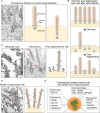COVID-19, cilia, and smell
- PMID: 32692465
- PMCID: PMC7426555
- DOI: 10.1111/febs.15491
COVID-19, cilia, and smell
Abstract
The novel coronavirus SARS-CoV-2 is the causative agent of the global coronavirus disease 2019 (COVID-19) outbreak. In addition to pneumonia, other COVID-19-associated symptoms have been reported, including loss of smell (anosmia). However, the connection between infection with coronavirus and anosmia remains enigmatic. It has been reported that defects in olfactory cilia lead to anosmia. In this Viewpoint, we summarize transmission electron microscopic studies of cilia in virus-infected cells. In the human nasal epithelium, coronavirus infects the ciliated cells and causes deciliation. Research has shown that viruses such as influenza and Sendai attach to the ciliary membrane. The Sendai virus enters cilia by fusing its viral membrane with the ciliary membrane. A recent study on SARS-CoV-2-human protein-protein interactions revealed that the viral nonstructural protein Nsp13 interacts with the centrosome components, providing a potential molecular link. The mucociliary escalator removes inhaled pathogenic particles and functions as the first line of protection mechanism against viral infection in the human airway. Thus, future investigation into the virus-cilium interface will help further the battle against COVID-19.
Keywords: COVID-19; SARS-CoV-2; cilia; smell loss.
© 2020 Federation of European Biochemical Societies.
Conflict of interest statement
The authors declare no conflict of interest.
Figures

Similar articles
-
Anosmia in COVID-19: Underlying Mechanisms and Assessment of an Olfactory Route to Brain Infection.Neuroscientist. 2021 Dec;27(6):582-603. doi: 10.1177/1073858420956905. Epub 2020 Sep 11. Neuroscientist. 2021. PMID: 32914699 Free PMC article. Review.
-
SARS-Coronavirus-2 Nsp13 Possesses NTPase and RNA Helicase Activities That Can Be Inhibited by Bismuth Salts.Virol Sin. 2020 Jun;35(3):321-329. doi: 10.1007/s12250-020-00242-1. Epub 2020 Jun 4. Virol Sin. 2020. PMID: 32500504 Free PMC article.
-
SARS-CoV-2 nsp13, nsp14, nsp15 and orf6 function as potent interferon antagonists.Emerg Microbes Infect. 2020 Dec;9(1):1418-1428. doi: 10.1080/22221751.2020.1780953. Emerg Microbes Infect. 2020. PMID: 32529952 Free PMC article.
-
Olfactory function and viral recovery in COVID-19.Brain Behav. 2021 Mar;11(3):e02006. doi: 10.1002/brb3.2006. Epub 2021 Jan 19. Brain Behav. 2021. PMID: 33465295 Free PMC article.
-
Can cilia provide an entry gateway for SARS-CoV-2 to human ciliated cells?Physiol Genomics. 2021 Jun 1;53(6):249-258. doi: 10.1152/physiolgenomics.00015.2021. Epub 2021 Apr 15. Physiol Genomics. 2021. PMID: 33855870 Free PMC article. Review.
Cited by
-
Emerging insights into CP110 removal during early steps of ciliogenesis.J Cell Sci. 2024 Feb 15;137(4):jcs261579. doi: 10.1242/jcs.261579. Epub 2024 Feb 28. J Cell Sci. 2024. PMID: 38415788 Free PMC article. Review.
-
Evaluation of a New Standardized Nasal Sampling Method for Detection of SARS-CoV-2 RNA via RT-PCR.Microorganisms. 2024 Jan 20;12(1):210. doi: 10.3390/microorganisms12010210. Microorganisms. 2024. PMID: 38276195 Free PMC article.
-
Interactions between SARS-CoV-2 and influenza, and the impact of coinfection on disease severity: a test-negative design.Int J Epidemiol. 2021 Aug 30;50(4):1124-1133. doi: 10.1093/ije/dyab081. Int J Epidemiol. 2021. PMID: 33942104 Free PMC article.
-
Upper Airway Mucociliary Clearance is Impaired in Dyspneic COVID-19 Patients.Indian J Otolaryngol Head Neck Surg. 2023 Jun;75(2):772-776. doi: 10.1007/s12070-022-03426-1. Epub 2023 Jan 19. Indian J Otolaryngol Head Neck Surg. 2023. PMID: 36714224 Free PMC article.
-
SARS-CoV-2 Infection Dysregulates Cilia and Basal Cell Homeostasis in the Respiratory Epithelium of Hamsters.Int J Mol Sci. 2022 May 4;23(9):5124. doi: 10.3390/ijms23095124. Int J Mol Sci. 2022. PMID: 35563514 Free PMC article.
References
-
- Rabaan AA, Al‐Ahmed SH, Haque S, Sah R, Tiwari R, Malik YS, Dhama K, Yatoo MI, Bonilla‐Aldana DK & Rodriguez‐Morales AJ (2020) SARS‐CoV‐2, SARS‐CoV, and MERS‐COV: a comparative overview, Le infezioni in medicina. Infez Med 28, 174–184. - PubMed
Publication types
MeSH terms
Substances
Grants and funding
LinkOut - more resources
Full Text Sources
Medical
Miscellaneous

